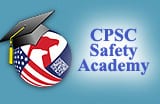Notes from the Recent CPSC Safety Academy 2013
During the recent CPSC Safety Academy held in Seattle, WA this month, there was a presentation given by Carol Cave, the  Assistant Executive Director (AED) of the Office of Import Surveillance and John Blachere, an International Trade Specialist in the Office of Import Surveillance for the CPSC on how the CPSC reviews shipments at ports.
Assistant Executive Director (AED) of the Office of Import Surveillance and John Blachere, an International Trade Specialist in the Office of Import Surveillance for the CPSC on how the CPSC reviews shipments at ports.
With the expansion of the tariff codes, the CPSC has the ability to target shipments with either high profile product groups, which may have experienced recalls or manufacturers who may have had problem products in the past. Based on this system, there were over 2 million shipments that were eligible for examination and out of these only 1,400 (0.070%) were detained with an average detention time of 13.4 days.
The products detained included; Toys (55%), Fireworks (14%), Clothing (9%), Holiday Light Sets (3%), Other Electrical Products (5%) and All Others (14%). Most of these products entered the United States by Sea (86%) with the other categories being; Rail (2%), Truck (6%) and Air (6%).
Of the 1,400 shipments stopped for examination 77% (1,022) were found to have violations with 61% (622) of those requiring seizure. These shipments were over the period from October 1, 2011 to September 5, 2013.
Of those violations that required seizure, the number one reason was for lead (34%) followed by a mechanical hazard (15%). While all of this was interesting, most of this information has been issued throughout the year in CPSC press releases. What was interesting was that during the QA portion of the presentation a question came up with regard to Children’s Product Certificates. The question was, how did the CPSC observe company’s complying with the requirement of certificates “accompanying each shipment”?
Carol and John both said that certificates were either physically with the products (in the containers themselves), included with the importation documents submitted by brokers or in a unique URL printed on the invoice, PO or other importation document.
They were then asked if they stopped and seized shipments strictly for not having a certificate for which they responded no. However, they did say that beginning in the fiscal year 2014 they will be looking to see if the shipment does have a proper certificate. This means that even if the shipment has passed the examination for chemical or physical hazard, the shipment can still be help up for a documentation (certificate) violation.

